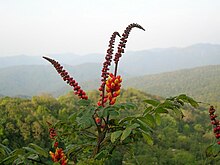
Biancaea sappan is a species of flowering tree in the legume family, Fabaceae, that is native to tropical Asia. Common names in English include sappanwood and Indian redwood. It was previously ascribed to the genus Caesalpinia. Sappanwood is related to brazilwood, and was itself called brasilwood in the Middle Ages.
Stuhlmannia moavi is a species of flowering plants in the legume family, Fabaceae. It is the only species in the genus Stuhlmannia. It is a tree native to Kenya, Tanzania, and Madagascar, where it grows in seasonally-dry tropical forest, woodland on limestone, and in riverine forest. The genus belongs to tribe Caesalpinieae in subfamily Caesalpinioideae.

Libidibia monosperma is a species of legume in the family Fabaceae, with the common names cóbana negra and cóbana polisandro. It is found in the Dominican Republic, Puerto Rico, and the United States Virgin Islands. It is a federally listed threatened species of the United States.

Haematoxylum is a genus of flowering plants in the legume family, Fabaceae, subfamily Caesalpinioideae and the tribe Caesalpinieae. It includes five species, four of which are native to the tropical Americas from Mexico to Colombia, and one to Namibia.
Cenostigma is a genus of flowering plants in the family Fabaceae. It includes 15 species native to the tropical Americas, ranging from Mexico to northwestern Argentina and southern Brazil. It belongs to the subfamily Caesalpinioideae and tribe Caesalpinieae. Cenostigma pluviosa is being investigated as a possible antimalarial medication.
Lophocarpinia aculeatifolia is a species of flowering plants in the legume family, Fabaceae. It is the sole species in genus Lophocarpinia. It is a tree native to Paraguay and northern Argentina. It belongs to tribe Caesalpinieae of subfamily Caesalpinioideae.
Pomaria is a genus of flowering plants in the legume family, Fabaceae. It includes 16 species of shrubs and perennial herbs native to North America, South America, and southern Africa. Typical habitats include drier subtropical grasslands and wooded grasslands, often on limestone, and degraded areas. It belongs to tribe Caesalpinieae of subfamily Caesalpinioideae.

The genus, Pterolobium, consists of 10 species of perennial flowering plants in the family Fabaceae, subfamily Caesalpinioideae and tribe Caesalpinieae. They are sometimes called redwings and are native to the tropical to subtropical climes of Africa and Asia, including Indonesia and the Philippines. They are large scrambling or climbing shrubs that grow in riverside thickets, on rocky slopes or at forest margins. They bear colourful samara fruit, and have pairs of thorns below the rachis of their bipinnate leaves.

The tribe Caesalpinieae is one of the subdivisions of the plant family Fabaceae: subfamily Caesalpinioideae.
Erythrostemon is a genus of flowering plants in the legume family, Fabaceae. Its native range is tropical & subtropical America.

Guilandina is a genus of flowering plants in the legume family, Fabaceae. It belongs to the subfamily Caesalpinioideae and tribe Caesalpinieae.
Coulteria is a genus of flowering plants in the legume family, Fabaceae. It belongs to the subfamily Caesalpinioideae. It includes ten species native the tropical Americas, from northern Mexico through Central America to Colombia and Venzezuela, including Cuba and Jamaica.

Mezoneuron is a genus of flowering plants in the legume family, Fabaceae. It belongs to the subfamily Caesalpinioideae and the tribe Caesalpinieae.

Tara is a genus of flowering plants in the legume family, Fabaceae. It includes three species of trees and shrubs native to the tropical Americas, from northern Mexico through Central America, the Caribbean, and western South America to Bolivia and Central Chile. Typical habitats include seasonally-dry tropical forest and semi-arid thorn scrub. It belongs to tribe Caesalpinieae of subfamily Caesalpinioideae.
Arquita is a genus of flowering plants in the family Fabaceae. It belongs to the subfamily Caesalpinioideae. It includes five species, which range from Ecuador to northern Argentina.
Biancaea is a genus of flowering plants in the family Fabaceae. It includes seven species, which range from Yemen to south Asia, Indochina, Malesia, China, Korea, and Japan. It belongs to the subfamily Caesalpinioideae and the tribe Caesalpinieae.
Denisophytum is a genus of flowering plants in the family Fabaceae. It belongs to subfamily Caesalpinioideae and tribe Caesalpinieae. It includes eight species, which have a disjunct distribution – northern Mexico, Florida and the Caribbean, southern South America, the Horn of Africa, the Arabian Peninsula, and Madagascar.

Gelrebia is a genus of flowering plants in the family Fabaceae. It belongs to the subfamily Caesalpinioideae. It includes eight species native to sub-Saharan Africa, which range from Ethiopia to the Democratic Republic of the Congo and South Africa.
Hererolandia pearsonii is a species of flowering plants in the family Fabaceae. It is the sole species in genus Hererolandia. It is a shrub endemic to Namibia where it grows in Karroo-Namib shrubland. It belongs to tribe Caesalpinieae of subfamily Caesalpinioideae.

Libidibia is a genus of flowering plants in the family Fabaceae. It includes seven species of trees and shrubs native to the tropical Americas, ranging from northern Mexico to northern Argentina. Typical habitats include seasonally-dry tropical forest and scrub, thorn forest, and savanna woodland. It belongs to the subfamily Caesalpinioideae.










